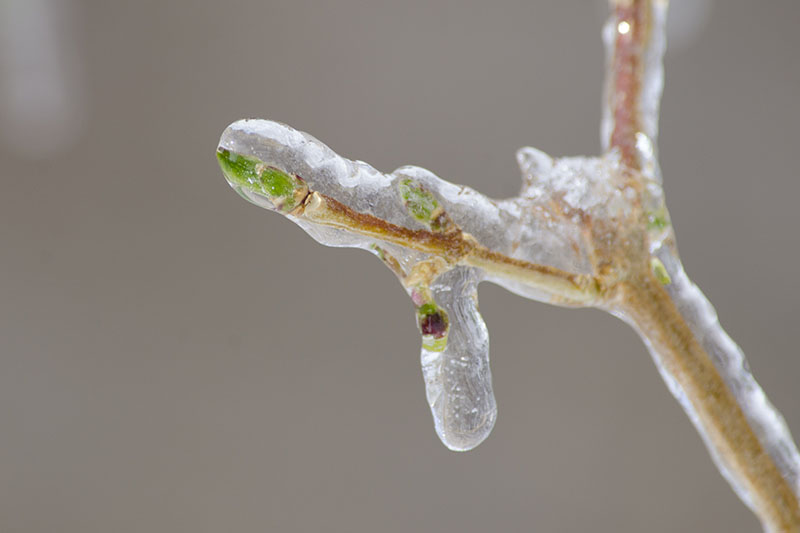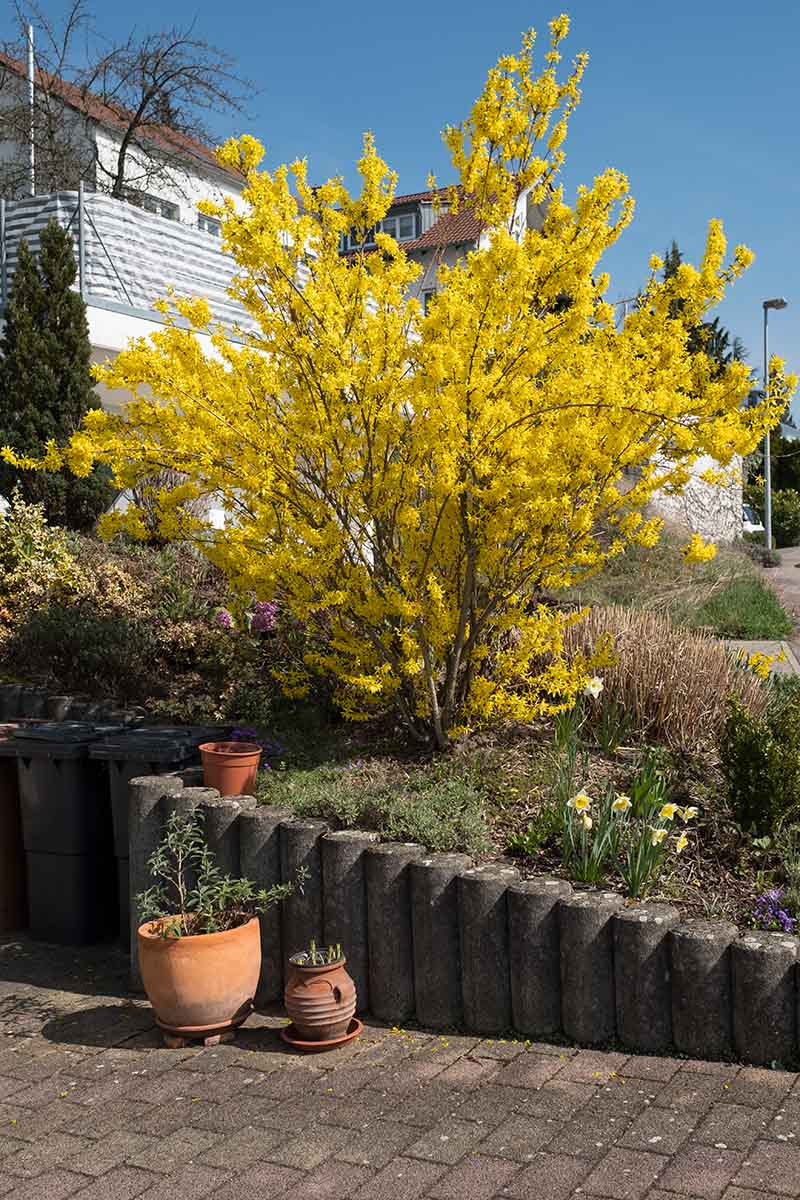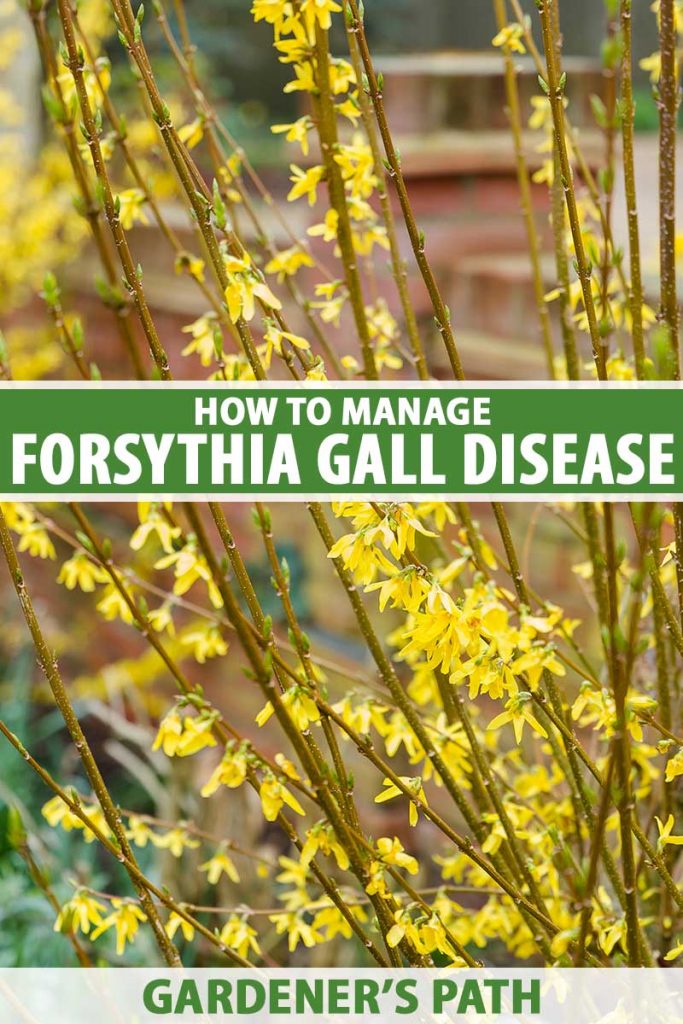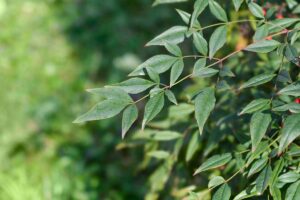Forsythia is a spring-blooming shrub suitable for cultivation in USDA Hardiness Zones 5-8.
It is a low-maintenance, robust plant that tolerates a variety of growing conditions, from dense clay soil to the juglone toxicity of black walnut trees.
Occasionally, this sturdy shrub develops knot-like, woody deformities called galls that may appear either individually or in clusters along the stems.

We link to vendors to help you find relevant products. If you buy from one of our links, we may earn a commission.
And while they may be most visible during the leafless winter months, they can appear in any season.
In our guide to growing forsythia, we discuss all you need to know to cultivate this shrub in your landscape.
In this article, we talk about what forsythia gall disease is and how to address it.
Here’s what we’ll cover:
What You’ll Learn
Any type of plant irregularity is a red flag. It’s important to evaluate any strange growth behavior that you notice, as it may turn out to be a disease that not only threatens the affected plant, but those nearby as well.
Let’s get started.
What Is Forsythia Gall Disease?
There are multiple types of swellings or growths that can appear on plants. Some may look like raised bumps on the leaves, others like smooth balloons on the branches.
They can pop up on flowers and foliage that have been chewed by sap-sucking insects, and even on roots infested with soilborne parasites.

Feeding bugs can spread bacterial, fungal, and viral infections that can stimulate plants to develop abnormal, raised growths that may appear bumpy, knotted, or swollen.
And while we know a lot about those caused by vectors such as aphids, mites, and root-knot nematodes, we know far less about the specific cause of forsythia galls.
To me, this type of growth looks like a thick clump of yellowish-brown flower buds, but instead of being tender to the touch, they are firm.
Described as knobby, knotty, and woody, these formations represent the presence of a disease of unconfirmed origin.
An article from the Cornell University College of Agriculture and Life Sciences Plant Disease and Diagnostic Clinic, updated in 2015, describes three causative factors believed to be responsible for producing nodular growth on forsythia, either individually or in combination:
Agrobacterium tumefaciens, aka Rhizobium radiobacter, and A. radiobacter are soilborne bacteria that cause crown gall growth, at the point where the roots meet the stems.
Phomopsis is a genus of gall-inducing ascomycete fungal pathogens (aka sac fungi) that contains numerous species that affect the foliage and wood of a variety of different trees and shrubs.
A genetic abnormality may predispose forsythia to gall formation.
Additionally, a study conducted in 2017 revealed that there is in fact a new potential culprit: Pseudomonas savastanoi – a pathogen known to be responsible for the development of cankers in olive and ash trees.
P. savastanoi is known as a gammaproteobacteria, which means that under a microscope it has a rod-like shape. It’s also endophytic, meaning it lives and multiplies inside plant tissue. Some endophytic bacteria and fungi may have a beneficial effect on the host plant – or, as in this case, cause abnormalities.
According to Doctor of Plant Medicine Raj Singh at the Louisiana State University AgCenter, in an article on gall-causing Pseudomonas savastanoi bacteria as it pertains to Loropetalum (Chinese witch hazel) and one of its common hosts, forsythia, “After the initial infection, galls may start to appear in two to three months.”
They gradually enlarge, and there may be multiple nodules on the same stem.
Regardless of the source, when a plant plays host to fungi or bacteria known to cause galls, these growths are most likely to form if plant tissue is already compromised.
This weakness may come in the form of broken stems, frost-bitten buds, moisture saturated foliage, damaged roots, insect infestation, or a combination of these and possibly other factors as well.

Galls may start out small, and there may be one or more along a length of stem. When they enlarge and begin to merge with one another, they can surround an entire stem like a ring, or girdle.
Over time, this can cause wilting, stem dieback, and in severe cases, shrub death.
To date, there is no effective treatment for forsythia galls.
So, what can we do?
Proactive Avoidance Measures
With best garden practices, we can minimize the risk of contracting this deforming, potentially fatal disease.

To begin with, always purchase quality shrubs from reputable purveyors. If you buy in person, examine them for signs of good health and the absence of abnormal growth before making your selections.
When planting shrubs, take into account their mature dimensions and space them appropriately to allow for optimal airflow. Even shrubs used to create hedges need to have room to grow to their full widths without crowding their neighbors.
Water at the soil level to avoid wetting the leaves and creating a breeding ground for fungal growth.
Disinfect pruning shears both before and after use. Sanitary tools go a long way toward preventing the spread of disease.
The pros of the Integrated Pest Management Program of the University of Missouri recommend using 70 percent isopropyl alcohol directly from the bottle, or a 10 percent bleach solution made with one part household bleach to nine parts water.
Do not under any circumstances mix the alcohol and bleach solution together.
When you are cutting stems for pruning purposes or flower arranging, avoid doing so during wet weather. Cutting opens wounds that are vulnerable to penetration by moisture-loving pathogens.
Prune shrubs immediately after flowering and remove any dead or dying branches to maintain airflow and avoid the build up of moisture and humidity around the plant.
Purge weeds and remove debris around shrubs to inhibit insect infestations that can weaken plants and make them susceptible to disease.
Forsythia is a non-native plant that is not prone to insect infestation, but if you notice eggs or bugs, apply neem oil or an insecticidal soap per package instructions.
Avoid accidental damage to plant tissue by keeping string trimmers (weed whackers) and mowers far from lower stems.
Similarly, try not to damage roots by inadvertently digging a new garden bed or sinking fence posts too close to them.
Caring for Affected Shrubs
If you see galls, don’t panic. They are easily removed in one of two ways.

Some folks like to cut off the affected stems to their points of origin.
Others prefer to preserve as much of each stem as possible, by cutting them four to six inches below each irregular woody mass, and leaving the rest intact.
If you have a shapely hedge and only a few knotty places, you may want to keep the pruning to a minimum. For more extensive disease along the stems, you may need to remove entire lengths.
Remember to sanitize your pruning shears as discussed above.
Seal up all pruned stems and place them in the trash. Some folks burn them, but we’re not all zoned for such a disposal method.
Forsythia is a fast grower, so recovery should be swift.
However, if galls are persistent and the stems are chronically wilted or failing to regenerate, it may be wise to remove entire shrubs from the garden and dispose of them.
If you remove a heavily diseased or dead shrub, it is recommended not to plant another forsythia or other gall-prone plant in the same location until scientists conclusively confirm the absence or presence of a soilborne causative factor. Examples include fruit trees and roses.
In addition, it is not a good idea to propagate new plants with stem cuttings from shrubs known to have harbored disease.
Responding with Awareness and Appropriate Action
The exact cause of forsythia galls continues to have an aura of mystery surrounding it, despite green thumbs pointed at bacterial and fungal pathogens as the likely factors.
This is because of the wildcard: genetic predisposition. Until proven otherwise, it’s possible that there’s a pre-wired vulnerability to the disease in the DNA of plants in the Forsythia genus.

The best we can do for these blossom-laden harbingers of spring is to use our best gardening practices to avoid triggering it, remove affected stems – and entire shrubs if necessary – when it rears its ugly head.
Have your forsythia plants suffered from galls? Let us know in the comments section below!
If you found this article informative and are interested in learning more about growing forsythia, check out these articles next:
- 7 Reasons Why Forsythia May Not Bloom
- 11 of the Best Forsythia Varieties for Glorious Spring Color
- 5 Common Causes of Forsythia Yellowing
- 7 Tips for Growing Formal and Informal Forsythia Hedges
© Ask the Experts, LLC. ALL RIGHTS RESERVED. See our TOS for more details. Uncredited photos: Shutterstock.




I just discovered galls on my Forsythia bushes today. I am glad I found your article and I will attempt to remove the affected branches tomorrow. My forsythia row is about 20 years old and has been a beautiful sight every spring.
Thank you for the information.
Hi Gail –
Thank you for reading. Forsythia is a very resilient shrub, and should readily regrow after you remove the gall-infected branches. It’s good to do a periodic deep pruning to maintain vigor. Our article, Hard Pruning Forsythia to Rejuvenate Shrubs, describes the process.
Like Gail…my Forsythia bushes are at least 20 years + old. Last spring I detected moderate gall disease and overall poor bush quality in my beloved Forsythia. I decided to do a heavy pruning ( disposal of debris and alcohol cleaning of pruning tool done ) and hope for the best. So far this spring…the regrowth looks healthy and is already about 3 feet tall in all bushes. We are the the midst of a 2nd severe drought season in our New England State. Could that be a contributing factor to the development of gall disease? Thank you.
Hi Pat –
It sounds like you’re doing a great job with sanitary gall remediation. The bacteria and fungus likely responsible for gall formation actually favor wet conditions. Drought can adversely affect shrubs that have been weakened by gall, so keep up the good work.
I discovered galls in my 10 year old Northern Gold Forsythia this year when doing the after bloom trimming.
I pruned away all the stems that had galls on them.
Im keeping an eye on the shrub now to see if galls reoccur.
Im wondering about doing a hard prune on it . I realize that that may affect next years bloom, and also wonder if it’s too late for that. It’s been a couple weeks since the blooms faded.
Hi Kathleen –
Pruning the stems with galls may be all your shrub needs for now. However, if you want to hard prune, it’s not too late.
I just saw my forsythia has wilting and leaves on their tips turning brown and area of brown clumps. Maybe this is galls. Had this forsythia for at least 30 years and never has seen this happen. It bloomed beautifully this spring. I have attached pictures. Your help is much appreciated!
Hi Alice, Thank you for showing pictures of your forsythia plants! I’m so sorry they ae drooping this badly. There could be a number of things going on: 1) Are you in a drought? Is it possible that your forsythia plants are not getting enough water? That can cause severe wilting. 2) Another possibility is that your plants are suffering from twig blight caused by Sclerotinia. This would fit with the inability of your fungicide to control the disease. Penn State has a number of recommendations on how to manage this disease: a) Don’t water overhead in the spring b)… Read more »
The gall started to affect my forsythias last year. I noticed that they are all infected now in one way or another. The healthier shrubs have some dead, wilted branches sticking out that I have to get to. Two I just cut back and I’m praying the new growth will win out. Also sprinkled Plant Tone around them for nutrients. The first one I noticed last year looks like any new growth hasn’t been affected yet. I also sprinkle corn meal because I read it was good for fungus. It helped a rhododendron come back from blight and it’s helping… Read more »
Hi Stephanie –
You have an excellent regimen!
We’re glad you found the article informative. Thanks for sharing.
I have a couple of Forsythia that seem to have gall, and I’ve been pruning for several years, but they are worse than ever, so I think I’ll remove them. Nearby Rhododendron and Lilac have dying branches and rotting trunk. Could the forsythia have done this? Should I replace all?
Hi Cheryl –
There is still much that is not understood about forsythia gall, but as mentioned, it is likely that an Agrobacterium, the same soilborne bacteria that causes crown gall, plays a role. Since both rhododendron and lilac are susceptible to crown gall, there may be a connection, and I suspect it lies in soil that is overly wet. As the problem seems to be affecting several types of shrubs, I recommend contacting your local agricultural extension for advice on the best course of action.
I was looking online to find help. I did find hope because I bought my location 5 yrs ago and it has 10 bushes and had galls from the beginning. My bushes live and grow so I guess there is hope but no cure. I watch for the galls and remove any I see all year and burn. I spray with ” Fruit tree spray, 3 in 1 for disease and pests” I only find at my local Co-Op. After I read article I’m not sure how much good it is doing but my bushes look healthy mostly, grow and… Read more »
Hi Judith –
As there is no cure for forsythia gall, removing them when you see them is the best action to take. If the shrubs are otherwise healthy, no treatment is needed.
I am with the lady below. My bush is about twenty years old and I just discovered the gall. I will trim it back
And watch it carefully. Thank you
Hi Suzanne –
You’re welcome. That is the best course of action with an otherwise healthy shrub. Happy gardening!
Ive just pruned a forsythia in my new house which looked to be quite an established plant & found lots of Gall buds. They’re focused on one side of the bush which compared to the other looks unhealthy. I’ve pruned it back a little harder than planned and cut out all the branches with ‘buds’ and am going to prune the other side to match. Thanks to this article I now know what they are and will keep an eye on it.
Hi Sarah –
Congratulations on your new home! We’re glad the article has been helpful. It sounds like you’re on the right track.
We have many forsythia bushes in our yard and most were there when when bought the house 32 years ago. One in particular is always magnificent, but has gotten quite large in the past few years and not been cut back enough. Today, our yard man was doing a serious cut back and we discovered the bush is covered in these galls. It bloomed very well this spring, (although we had several unusual very cold spells while it was blooming which seemed to stunt it’s blooming at one point) and has been full leafed and green all summer, so I… Read more »
Well, I don’t know what I’m doing wrong, but I can’t get the photos to post.
Hi Beth –
Your forsythia are lovely in bloom.
It is very disappointing to discover galls. Deep pruning is the best course of action. As the origin of galls remains unclear to botanists, there are no treatments for either the affected shrubs or the soil.
Be sure to sanitize all pruning equipment after use.
Next spring, when the new shoots grow, apply a well-balanced, slow-release granular fertilizer per package instructions. Flowering is likely to be reduced due to the removal of budded stems during the deep pruning.
Hi Beth, apologies for the pictures having problems loading, I’ve attached them here!